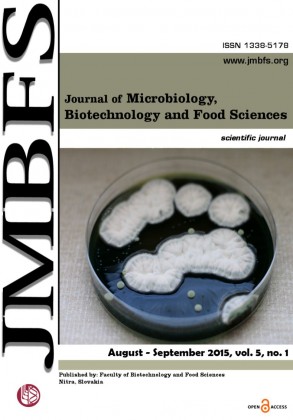THE EFFECT OF FIBRE FROM VARIOUS ORIGINS ON THE PROPERTIES OF DOUGH AND BAKERY PRODUCTS
DOI:
https://doi.org/10.15414/jmbfs.2015.5.1.73-80Keywords:
bread, dough, inulin, malt, Potex, barley, rheology, organoleptic qualityAbstract
Wheat bread is a major component of people´s diet all over the world. There has been increasing demand for food products with additional health benefits. Fibre is an important component of diet and nutrition and is one of the groups of biologically important substances consumed in insufficient quantity. In this respect, the enrichment of bread with the functional fibre is interest for the consumer as well as the cereal industry. Different materials can serve as a source of fibre for bread, either directly industrially prepared (inulin, potato fiber) or natural materials with a high content of fibre. The aim of this work was to monitor changes in quality parameters of flour, dough and bread depending on the type and amount of addition.Mixes of wheat flour and additives were prepared by substitution of wheat flour by 5, 10, 15, 20 and 25% of inulin; 1, 3, 5 and 7% of potato fiber; 5, 10, 15, 20 and 25% of malt; 10, 20, 30, 40 and 50% of naked barley. For the evaluation of dough Farinograph was used; bread quality was evaluated 24 hours after baking (volume, specific loaf volume, volume efficiency, cambering etc.). The sensory evaluation was conducted according to sensory descriptor. The addition of fibre as nutritionally important component is justified by the positive impact on the health of consumers. However non-bakery crops contain elements which might negatively influence the technological properties. Based on the results obtained by observing the rheological properties of the tested doughs, it can be stated that the use of additives worsened the physical properties of doughs and the technological and organoleptic quality of final products. The composite flours had longer dough development time and dough stability, whereas the degree of dough softening decreased caused by destruction and shortening of gluten. Dough showed worse workability and the decrease of the water absorption which is undesirable from an economic point of view since it increases the amount of flour needed to produce bread of the same weight. The loaves prepared with an addition were evaluated to be of a lesser quality from the technological point of view in comparison with pure wheat loaves. The additions reduced the volume of bread except for barley which in addition up to 30% has increased the bread volume in comparison to control loaves. Based on comprehensive evaluation (including organoleptic) maximum acceptable additions can be recommended as follows: inulin up to 5% , potato fiber up to 7%, malt up to 10% and naked barley up to 30%. Fiber content bread with the recommended added amount was 5.13% for inulin, 7.80% for potato fiber, 4.98% for matl and 6.75% for naked barley.
Downloads
Download data is not yet available.
Downloads
Published
2015-08-01
How to Cite
IvaniÅ¡ová, E., Tokár, M., & Bojňanská, T. (2015). THE EFFECT OF FIBRE FROM VARIOUS ORIGINS ON THE PROPERTIES OF DOUGH AND BAKERY PRODUCTS. Journal of Microbiology, Biotechnology and Food Sciences, 5(1), 73–80. https://doi.org/10.15414/jmbfs.2015.5.1.73-80
Issue
Section
Food Sciences
License
Copyright (c) 2015 Eva Ivanišová, Marián Tokár, Tatiana Bojňanská

This work is licensed under a Creative Commons Attribution 4.0 International License.
All papers published in the Journal of Microbiology, Biotechnology and Food Sciences are published under a CC-BY licence (CC-BY 4.0). Published materials can be shared (copy and redistribute the material in any medium or format) and adapted (remix, transform, and build upon the material for any purpose, even commercially) with specifying the author(s).





